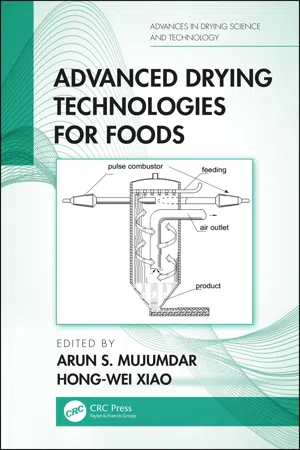
Advanced Drying Technologies for Foods
- 246 pages
- English
- ePUB (mobile friendly)
- Available on iOS & Android
Advanced Drying Technologies for Foods
About This Book
The goal of all drying research and development is to develop cost-effective innovative processes that yield high-quality dried products with less energy consumption and reduced environmental impact. With the literature on drying widely scattered, Advanced Drying Technologies for Foods compiles under one cover concise, authoritative, up-to-date assessments of modern drying technologies applied to foods. This book assembles a number of internationally recognized experts to provide critical reviews of advanced drying technologies, their merits and limitations, application areas and research opportunities for further development.
Features:
-
- Provides critical reviews of advanced drying technologies
-
- Discusses the merits and limitations of a variety of food drying technologies
-
- Explains drying kinetics, energy consumption and quality of food products
-
- Reviews the principles and recent applications of superheated steam drying
The first four chapters deal with recent developments in field-assisted drying technologies. These include drying techniques with the utilization of electromagnetic fields to deliver energy required for drying, for example, microwave drying, radio frequency drying, electrohydrodynamic drying, and infrared radiation drying. The remainder of this book covers a wide assortment of recently developed technologies, which include pulse drying, swell drying, impinging stream drying, and selected advances in spray drying. The final chapter includes some innovative technologies which are gaining ground and are covered in depth in a number of review articles and handbooks, and hence covered briefly in the interest completeness.
This book is a valuable reference work for researchers in academia as well as industry and will encourage further research and development and innovations in food drying technologies.
Frequently asked questions
Information
1 Electrohydrodynamic Drying
1.1 INTRODUCTION
- Electroporation (electropermeabilization) where the material is exposed to a series of short-time (microseconds) strong electric field (over 22 kV/cm) pulses which result in discharge of electric sparks perforating the skin and disrupting the cellular structure of fruits, berries, or vegetables, thus facilitating the mass transfer in subsequent processes such as osmotic dehydration (Amami et al., 2005) or extraction of valuable compounds (Sack et al., 2010; Loginova et al., 2011; Boussetta and Vorobiev, 2014).
- Application of high-voltage pulsed electric fields (PEFs) for inactivation of microorganisms, spores, and enzymes in liquid foods. Comprehensive yet concise information on PEF in various applications to foods is given by Barbosa-Canovas and Zhang (2001).
- Alteration of the properties of fruits, vegetables, and other biomaterials in order to extend their shelf life, increase germination, and preserve antioxidant capacity and enzyme activity. Such perishable materials are placed between two parallel plate electrodes connected to a high-voltage power supply (Atungulu et al., 2005; Bajgai et al., 2006; Wang et al., 2008).
- Any technologies based on the movement of ions in HVEF, thus giving rise to EHD micro/meso-pumps, thrusters, coolers, etc. (Seyed-Yagoobi, 2005; Aryana et al., 2016).
- Dielectric barrier discharge (DBD) where high alternating current (AC) voltage is applied to electrodes with a dielectric material in between electrodes. It generates cold plasma, which is used for sterilization of food products (Mir et al., 2016) or polymeric packaging surfaces (Pankaj et al., 2014).

1.2 FUNDAMENTALS OF EHD TECHNOLOGY
Table of contents
- Cover
- Half Title
- Series Page
- Title Page
- Copyright Page
- Table of Contents
- Preface
- Editors
- Contributors
- Chapter 1 Electrohydrodynamic Drying
- Chapter 2 Drying and Instant Controlled Pressure Drop Swell Drying: Towards High-Quality Dried Foods and Starch-Free Snacks
- Chapter 3 Advances in Impinging Stream Processing of Agricultural and Biological Products
- Chapter 4 Pulse Combustion Drying
- Chapter 5 Advances in Production of Food Powders by Spray Drying
- Chapter 6 Advances in Microwave Drying
- Chapter 7 Infrared Radiation-Assisted Drying of Agricultural Products
- Chapter 8 Radio Frequency Drying of Agricultural Products and Foods
- Chapter 9 Miscellaneous Drying Technologies
- Chapter 10 Advances in Intermittent Batch Drying of Foods
- Index